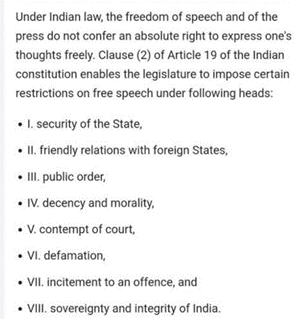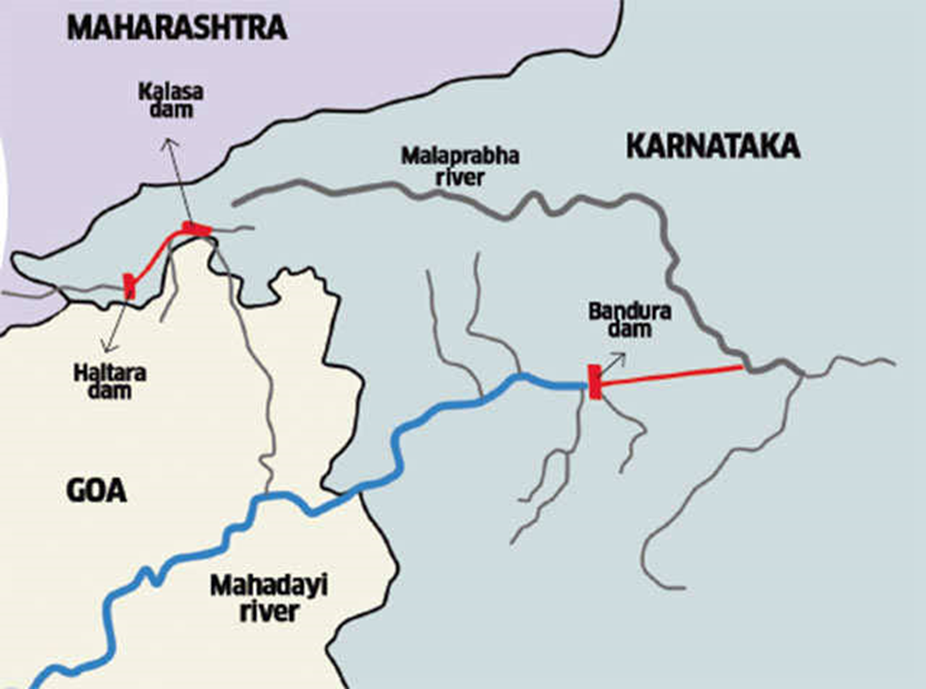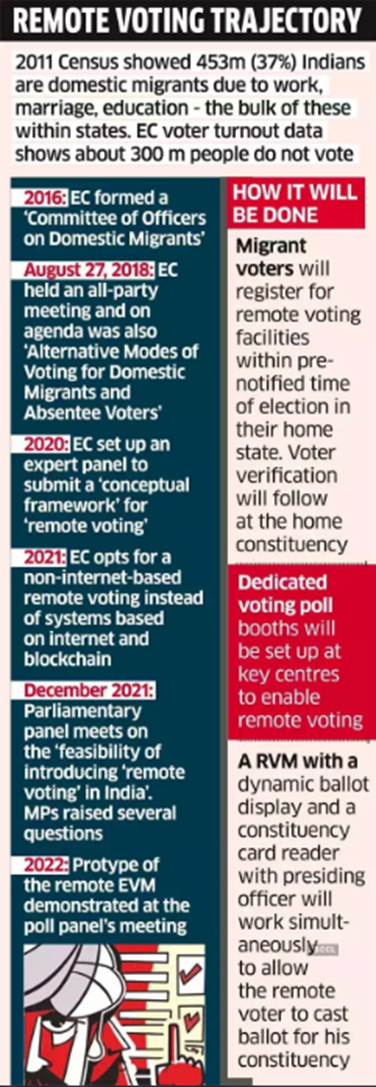Friday, 6th January 2023
Assam delimitation: Why now, what are the concerns raised
Context:
The Election Commission has begun the process of delimitation, or redrawing of electoral boundaries, in Assam for both Assembly and Parliamentary constituencies.
- Delimitation has not been carried out in Assam since 1976.
- The process was announced by the Election Commission on December 27, 2022, after the government requested it in November of the same year.
Why is delimitation being done in Assam alone?
The delimitation process was previously completed in 2008 but was not carried out in Assam, Arunachal Pradesh, Manipur, Nagaland, and Jammu and Kashmir due to security concerns and the potential for disturbing law and order.
- In 2020, a Delimitation Commission was established for these states, but in 2021, the commission's mandate was extended only for Jammu and Kashmir.
Issues surrounding:
Discrimination against certain communities: The process has been met with some controversy and criticism, with some alleging that it is being rushed and could lead to discrimination against certain communities.
Alter the demographics: The delimitation process has also been linked to the issue of illegal immigration in the state, with some claiming that it could be used to alter the demographics of certain areas and advantage certain political parties.
Section 8A of the Representation of the People Act, 1950:
The Election Commission has the authority to redraw the boundaries of parliamentary and assembly constituencies in Arunachal Pradesh, Assam, Manipur, and Nagaland, according to Section 8A of the Representation of the People Act, 1950.
The President of India has the power to allow this process to take place if they believe that the conditions in these states are suitable for delimitation to occur.
Revisit Assisted Reproductive Tech Age Limit: Kerala HC
Context:
The Kerala High Court has called for a review of the upper age limit for assisted reproductive technology (ART) treatment in India.
- The court also noted that the upper age limit for ART treatment is higher in other countries and should be revised in light of advancements in medical technology.
What's the issue now?
The current age limit is 50 years for women and 55 years for men under the Assisted Reproductive Technology (ART) (Regulation) Act, 2021, for undergoing the assisted reproductive technology.
- The court has argued that this limit is arbitrary and infringes on the reproductive rights and privacy of women.
Need of the hour:
While the State has the power to impose reasonable restrictions, such restriction can always be tested on the touchstone of liberty guaranteed under Article 21.
What next?
The High Court has directed the National Assisted Reproductive Technology and Surrogacy Board to alert the Union government about the need for having a relook at the upper age limit prescribed for using assisted reproductive technology.
Govt. Staff have no right to call strike: HC
Context:
The Kerala High Court ruled that there is no constitutional protection for state government employees who participate in a general strike.
What's the issue?
The court made this ruling in response to a petition filed by the Kerala State Government Employees Association, which challenged the disciplinary action taken against a group of employees who participated in a general strike in 2018.
Key observations made by the court:
- The participation of government employees in a strike would result in the disruption of essential public services, which is not in the public interest.
- The right to strike is not an absolute right and can be restricted by law in the interests of the general public.
Is it a constitutional right?
Strike is not expressly recognized in the Constitution of India. The Supreme Court settled the case of Kameshwar Prasad v. The State of Bihar 1958 by stating that strike is not a fundamental right.
Who was Birsa Munda? - Edukemy Current Affairs
Context:
The Chief Minister of Odisha, Naveen Patnaik, inaugurated the Birsa Munda Hockey Stadium in Rourkela ahead of the Hockey World Cup in 2023.
- The Hockey World Cup is being held in India for the first time, and the Birsa Munda Hockey Stadium will host some of the matches.
Who was Birsa Munda?
Bisra Munda was a folk hero and freedom fighter from the Munda tribe in Bihar and Jharkhand, India, who lived in the 19th century during British colonization.
He is also known as "Dharti Abba" or "Earth Father."
Bisra started a movement called "Ulgulan," or "The Great Tumult," to protest against the exploitation and discrimination of tribals. He also founded the Birsait faith, which encouraged prayer, abstention from alcohol, belief in God, and a code of conduct among tribals.
- He also founded the Birsait faith, which encouraged prayer, abstention from alcohol, belief in God, and a code of conduct among tribals.
- Bisra's efforts led to the passage of the Chotanagpur Tenancy Act in 1908, which protected the land rights of tribals.
- The Munda Rebellion, led by Birsa Munda in 1899-1900, was a significant tribal movement that protested against British land policies, the takeover of tribal land by Hindu landlords and moneylenders, and the criticism of traditional culture by missionaries.
- The rebellion helped to bring about legal protections for tribal land and demonstrated the ability of tribal people to resist injustice and protest against colonial rule.
Supreme Court’s ruling on Article 19
Context: Recently, the Supreme Court has ruled that a citizen can seek enforcement of the fundamental rights to freedom of speech not just against the state.
- By this ruling, the Supreme Court has, effectively, extended the ground for seeking these rights against other citizens.
Key highlights of Supreme Court’s order:
- The 4-1 majority the Constitution Bench said, “A fundamental right under Article 19/21 can be enforced even against persons other than the State or its instrumentalities”.
- The right of free speech and expression guaranteed under the Article 19(1)(a) cannot be curbed by any additional grounds other than those already laid down in Article 19(2).
- The Court relied on the 2017 verdict in Puttaswamy where a nine-judge bench unanimously upheld privacy as a fundamental right.
- The government argued that privacy is a right enforceable against other citizens and, therefore, cannot be elevated to the status of a fundamental right against the state.
- The Court also referred to several foreign jurisdictions, and said, “No jurisdiction in the world appears to be adopting, at least as on date, a purely vertical approach or a wholly horizontal approach.
|
What are vertical and horizontal application of rights?
|
Implications:
- The court, extending free speech against private citizens, opens up a range of possibilities in Constitutional law.
- This interpretation could also bring an obligation on the state to ensure private entities also abide by Constitutional norms.
What is Delimitation? - Edukemy Current Affairs
Context:
The Constitution of India requires that the boundaries of Assembly constituencies be redrawn after every decadal Census.
- However, amendments made in 1976 and 2001 have postponed the delimitation process for 25 years each time.
- Delimitation has been carried out nationwide four times so far, in 1952, 1962, 1972, and 2002, and is currently on hold until 2026.
Objective:
The objective is to have equal representation to equal segments of the population and ensure a fair division of geographical areas so that all political parties or candidates contesting elections have a level playing field in terms of the number of voters.
Composition of the Commission:
According to the Delimitation Commission Act, 2002, the Delimitation Commission will have three members: a serving or retired judge of the Supreme Court as the chairperson, and the Chief Election Commissioner or Election Commissioner nominated by the CEC and the State Election Commissioner as ex-officio members.
Constitutional Provisions:
The Parliament enacts a Delimitation Act under Article 82 of the Constitution and an independent high-powered panel known as the Delimitation Commission is constituted to carry out the exercise.
As mandated under Article 170 of the Constitution, census figures (2001) shall be used for the purpose of readjustment of parliamentary and assembly constituencies in the state.
Reservation of seats for the Scheduled Castes and Scheduled Tribes will be provided as per Articles 330 and 332 of the Constitution of India.
The Assisted Reproductive Technology (ART) (Regulation) Act, 2021
Context:
The ART Act was introduced on January 25, 2022.
It aims to regulate the use of assisted reproductive technologies, such as in vitro fertilization (IVF) and surrogacy.
Overview of the Surrogacy Act, 2021:
It came into effect in January this year.
- It allows ‘altruistic surrogacy’ — wherein only the medical expenses and insurance coverage is provided by the couple to the surrogate mother during pregnancy.
- Creates a national board to lay down and implement a code of conduct for people working at IVF clinics.
- It intends to make genetic testing of the embryo mandatory before implantation for the benefit of the child born through ART.
- It also seeks to streamline the cryo-preservation processes for sperm, oocytes and embryos.
- It also proposes to constitute a national registry and registration authority to maintain a central database and assist the national board in its functioning.
Eligibility conditions to make use of the services of a surrogate mother:
- Any couple that has ‘proven infertility’.
- The couple should be Indian citizens who have been married for at least five years.
- The female must be between 23 to 50 years and the male, 26 to 55 years.
- They cannot have any surviving children (biological, adopted or surrogate); However, this would not include a ‘child who is mentally or physically challenged or suffers from life threatening disorder or fatal illness.’
Who can be a surrogate mother?
Only a close relative of the couple can be a surrogate mother, one who is able to provide a medical fitness certificate. She should have been married, with a child of her own, and must be between 25 and 35 years, but can be a surrogate mother only once.
Controversy over Delhi ‘aldermen’
Context: recently, Delhi’s Lt. Governor, VK Saxena, nominated 10 aldermen amidst significant controversy. The 10 nominees, all BJP members, are expected to play a crucial role in determining who controls the Municipal Corporation of Delhi (MCD).
What is ‘alderman’?
- “Alderman” refers to a member of a city council or municipal body, with exact responsibilities depending on the location of its usage.
Duties and Responsibilities:
- Aldermen have duties and responsibilities similar to those of council members or councillors, such as participating in council meetings, voting on legislation, and representing the interests of their constituents.
Key points:
- The term "alderman" is derived from the Old English word "ealdorman," which means "elder man."
- Aldermen are typically elected to represent a specific ward or district within a city.
- In some jurisdictions, the title "alderman" may be used interchangeably with "councillor," while in others it may refer to a specific role within the council with additional powers or responsibilities.
The aldermen provision in Delhi:
As per the Delhi Municipal Corporation Act, 1957, ten people, over the age of 25 can be nominated to the corporation by the administrator (the Lieutenant Governor).
- These people are expected to have special knowledge or experience in municipal administration.
- They are meant to assist the house in taking decisions of public importance.
Tokyo's Demographic Crisis: Japan's New Drift
What is it?
Tokyo drift is referring the new measures Japan is applying to address its demographic crisis.
Key points about Japan’s demographic crisis:
- Japan is facing a demographic crisis due to its declining population and aging society.
- The government has implemented various measures to address this issue, including increasing immigration and promoting higher birth rates.
- However, these measures have had limited success and the population continues to decline.
- Japan's declining population and aging society have significant economic and social implications, including a shrinking workforce and increased pressure on the country's social security system.
- The government is now considering more radical measures to address the demographic crisis, such as incentivizing people to have more children and easing restrictions on immigration.
Measures taken:
- The Japanese government is offering young families in Tokyo 1 million yen (about $7,600) per child to move to the hinterlands, or even the more hilly and less inhabited regions of the greater Tokyo area.
Concerns:
- As far as money goes, it’s always cheaper to live outside the realm of overpriced real estate.
- It is likely that the Japanese government is trying to capitalise on a ground level shift. It remains to be seen if the lure of city lights holds out, or not.
Purchasing Managers' Index (PMI)
Context: Recent macro-economic data based on Purchasing Managers’ Index (PMI) for the manufacturing and services sectors offer mixed signals on the underlying momentum in the economy.
What is the PMI?
- Purchasing Managers’ Index or PMI is an economic indicator, which is derived after monthly surveys of different companies.
- The index shows trends in both the manufacturing and services sector.
- The index is compiled by S&P Global from responses to questionnaires sent to purchasing managers in a panel of around 400 manufacturers.
Significance:
PMI is one of the closely watched indicators of business activity and helps in predicting the economic health of a country.
- The index helps in determining whether the market conditions, as seen by purchasing managers, is expanding, contracting or staying the same.
- It is used to provide information regarding the current and future business conditions.
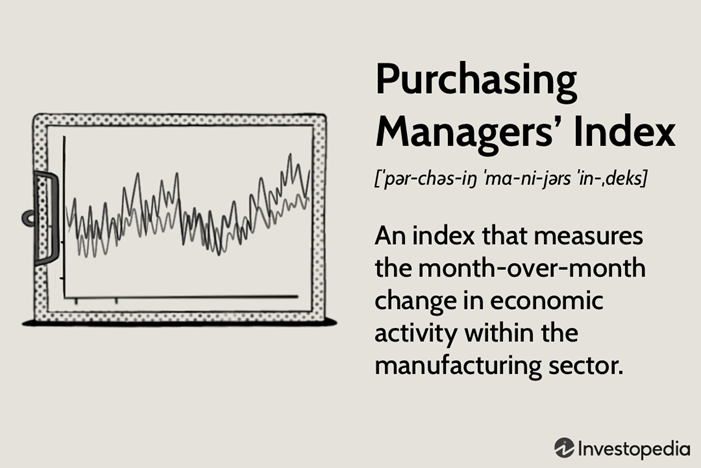
Types of PMI:
There are two types of PMI — Manufacturing PMI and Services PMI. A combined index is also made using both manufacturing PMI and services PMI.
National Exit Test - Edukemy Current Affairs
Context: The draft National Medical Commission bill 2022 seeks to introduce a fifth autonomous body under the country’s apex medical education regulator to conduct the National Exit Test (NExT).
What is it?
The NexT is a common exit exam envisaged by the government to standardize medical education across the country.
- It was proposed by National Medical Commission (NMC) as a part of the bill passed in 2019.
- This exam is set to replace the NEET PG and FMGE exams.
- There is no restrictions to the number of attempts for the NExT exam, however, a medical student must complete both steps of the test within 10 years of joining the MBBS course.
The proposed NExT exam will serve as:
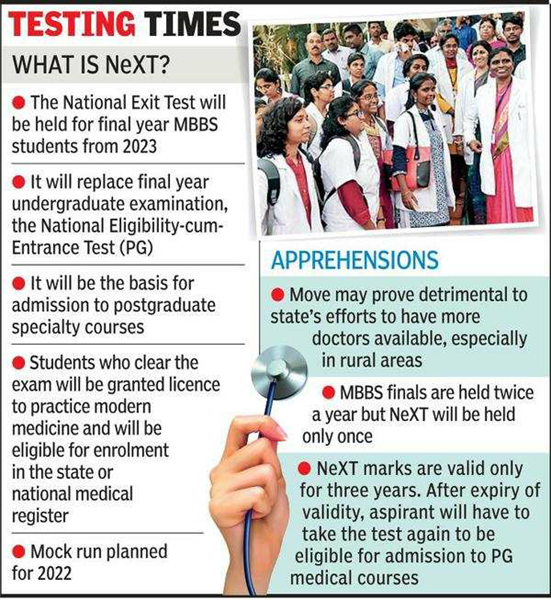
- An entrance test for admission to postgraduate medical courses.
- A licentiate exam to practice modern medicine.
- A common qualifying final-year MBBS exam, and a screening test for foreign medical graduates.
Stages of NexT:
According to the National Medical Commission, the test will be held in two stages: NExT step 1 and NeXT step 2.
- NExT step 1 will be a centralized common all India examination of multiple-choice questions.
- NExT Step 2 will be a Practical/Clinical and Viva Voce examination covering seven clinical subjects/disciplines.
Corporate tax - Edukemy Current Affairs
- Context: Recently Corporate tax to GDP ratio exceeded 3 percent after two years in FY'22.
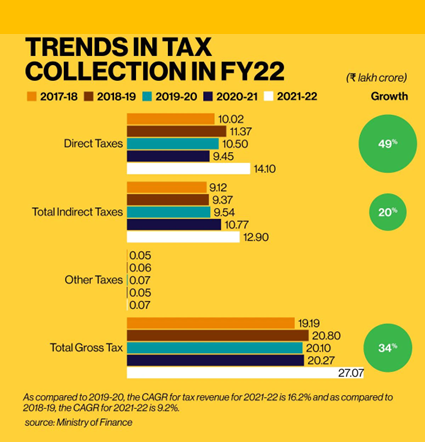
- In India, companies registered under Companies Act 1956, whether public or private, pay corporate tax. Foreign companies are also liable to pay it.
- It is a direct tax levied on a company's net income or profit as per the provisions of the Income Tax Act, 1961.
- The Corporate Tax rate is based on a slab rate system depending on the type of corporate entity and the different revenues earned by each of corporate entities.
- Operating earnings of a company are determined by deducting costs from the cost of the product sold (COGS), operating expenses and income depreciation.
- Relevance of Corporate
-
- To fund public goods and services (schools, hospitals, roads, and defense)
- For the redistribution of wealth
- To addresses income inequality
- If the corporate tax in a country is high, it does not attract much investment. Therefore, businesses are more like to invest in a particular area where tax burden is less (example: Singapore.)
Sources:
https://www.business-standard.com/about/what-is-corporate-tax#collapse
https://www.newindianexpress.com/business/2023/jan/01/corporate-tax-to-gdp-ratio-exceeds-3-percent-after-two-years-in-fy22-2533695.html
Currency in Circulation - Edukemy Current Affairs
- Context: According to the Reserve Bank data, post demonetization currency in circulation (CIC) in value terms soared recently.

- Currency in circulation refers to the amount of cash–in the form of paper notes or coins–within a country that is physically used to conduct transactions between consumers and businesses.
- Currency in circulation is all of the money that has been issued by a country's monetary authority, minus cash that has been removed from the system.
- It also represents portion of the overall supply being stored in checking and savings accounts.
- Impacts of Money circulation
-
- If there is too much money in circulation, both in terms of cash and credit, then the value of legal tender decreases, causing demand-pull inflation.
- Opposite effects occur when the supply of money falls or when its rate of growth declines. Economic activity declines and either disinflation (reduced inflation) or deflation (falling prices)
Source:
https://www.investopedia.com/terms/c/currency-in-circulation.asp
https://www.thehindu.com/business/Economy/currency-in-circulation-rises-by-83-since-demonetisation-in-2016/article66329529.ece#:~:text=According%20to%20the%20Reserve%20Bank,crore%20on%20December%2023%2C%202022
Digitalizing Ayushman Bharat: Accessible Healthcare
Context:
The COVID-19 pandemic has highlighted the benefits of digital innovation and technology-enabled solutions in the healthcare sector.
- Prior to the pandemic, private entities, health technology players, and the public sector were already working towards digitization in the healthcare industry.
- In recognition of the need for a comprehensive digital healthcare ecosystem to bring together existing siloed efforts and move towards proactive, holistic, and patient-centric healthcare, the Indian government has created shared public goods for healthcare and developed a framework for a nationwide digital health system.
The Ayushman Bharat Digital Mission (ABDM) was launched by the government in September 2021 to address these issues and bring healthcare in India to a turning point.
How has ABDM addressed these issues?
- The Ayushman Bharat Digital Mission (ABDM) has implemented key components to bring together all stakeholders in the digital healthcare ecosystem in India.
- The Ayushman Bharat Health Account (ABHA) creates a standard identifier for patients across healthcare providers.
- The ABHA and its associated Personal Health Record (PHR) app allow citizens to link, store, and share their health records in order to access healthcare services with autonomy and consent.
- The Health Facility Registry (HFR) and the Health Professional Registries (HPR) provide verified digital identities to large and small public and private health facilities and professionals.
- The ABDM has already reached significant milestones, with over 300 million ABHAs and 50 million health records linked.
Other digital initiatives planned by the government for the healthcare sector:
- The Unified Health Interface (UHI) is a Digital Public Good being developed by the Indian government to enable all healthcare service providers and end-user applications to interact with each other on its network.
- The government is repurposing Aarogya Setu and CoWIN to support the UHI: Aarogya Setu will be transformed into a general health and wellness application, and CoWIN will be integrated with a lite Hospital Management Information System (HMIS) for small clinics.
- The government is also introducing Heal by India, a platform that will make India's healthcare professionals' services available worldwide.
- A platform is being developed to automate the allocation of deceased organ and tissue donations, in order to make the process faster and more transparent.
Need of the hour:
Digitise and automate the insurance claim settlement process through the Health Claim Exchange platform.
- This will make claim-related information verifiable, auditable, traceable and interoperable among various entities, enabling claim processing to become inexpensive, transparent and carried out in real time.
Water Vision@2047: - Edukemy Current Affairs
Context: The 1st All India Annual States' Ministers Conference on "Water Vision@2047" was started in Bhopal, Madhya Pradesh.
Organized by: the Union Jal Shakti Ministry.
The objectives of the conference are:
- To deliberate on Water Vision for India for the next 25 years i.e., till 2047 as part of the larger plan of India@2047.
- To bring together key policymakers for debating and deliberating on ways to optimally utilise water resources for holistic economic and human development in a sustainable manner.
'Eat Right Station' certification
Indian Railways’ Varanasi Cantt Railway Station has been awarded a 5- star 'Eat Right Station' certification for providing high-quality, nutritious food to passengers.
- This certification is granted by FSSAI to railway stations adhering to standard food storage and hygiene practices.
The other railway stations with Star certification include:
- Anand Vihar Terminal Railway Station (Delhi);
- Chhatrapati Shivaji Terminus (Mumbai);
- Mumbai Central Railway Station, (Mumbai);
- Vadodara Railway Station,
- Chandigarh Railway Station, and
- Bhopal Railway Station.
What is it?
The 'Eat Right Station' certification is part of the 'Eat Right India' movement - a large-scale effort by FSSAI to transform the country's food system to ensure safe, healthy and sustainable food for all Indians.
- It is awarded by FSSAI to railway stations that set benchmarks in providing safe and wholesome food to passengers.
How the certificate is awarded?
- The station is awarded a certificate upon a conclusion of an FSSAI-empanelled third-party audit agency with ratings from 1 to 5.
- The 5-star rating indicates full compliance by the station to ensure safe and hygienic food is available to passengers.

Manohar International Airport - Edukemy Current Affairs
Recently, the Union Cabinet gave ex-post facto approval for naming Greenfield International Airport Mopa in Goa as ‘Manohar International Airport–Mopa, Goa’.
- With the new facility at Mopa, Goa has now got another international airport which is located 50 km apart from the south Goa-based Dabolim facility, operated as a civil enclave in the Indian Navy's air station INS Hansa.
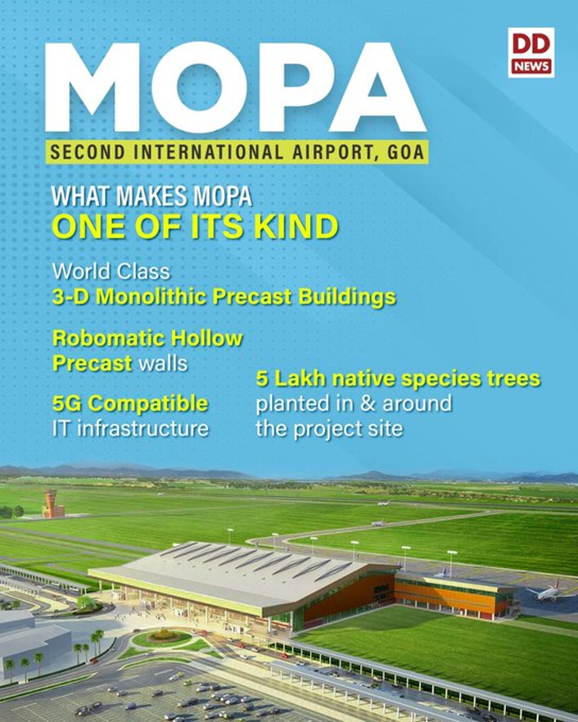
Offshore Security Co-ordination Committee
Context:
Recently, the 134th meeting of the Offshore Security Co-ordination Committee (OSCC) was held under the Chairmanship of Director General, Indian Coast Guard, V S Pathania at Varanasi.
About the OSCC:
The OSCC was constituted by the erstwhile Ministry of Petroleum, Chemicals and Fertilizers in 1978, to ensure smooth and effective functioning of offshore security arrangements.
- The OSCC is the apex body for reviewing and evaluating Offshore Security in India.
- The Committee was revamped and expanded in 2006 under the aegis of Ministry of Petroleum and Natural Gas.
- The Committee comprises of members drawn from the Indian Coast Guard, Navy, Air Force, IB, State Police, DG Shipping and ONGC.
- The Committee meets every six months to examine issues related to the safety and security of offshore assets.
CJI recuses self from hearing petition against Kunal Kamra
Context:
The Chief Justice of India (CJI), Sharad Arvind Bobde, has recused himself from hearing a case related to comedian Kunal Kamra.
- The case involves allegations of contempt of court against Kamra, who was accused of making derogatory remarks against the Supreme Court on social media.
What is Judicial Disqualification or Recusal?
Judicial disqualification, referred to as recusal, is the act of abstaining from participation in an official action such as a legal proceeding due to a conflict of interest of the presiding court official or administrative officer.
Grounds for Recusal:
- The judge is biased in favour of one party, or against another, or that a reasonable objective observer would think he might be.
- Interest in the subject matter, or relationship with someone who is interested in it.
- Background or experience, such as the judge’s prior work as a lawyer.
- Personal knowledge about the parties or the facts of the case.
- Ex parte communications with lawyers or non-lawyers.
- Rulings, comments or conduct.
Are there any laws in this regard?
There are no definite rules on recusals by Judges.
- However, In taking oath of office, judges, both of the Supreme Court and of the high courts, promise to perform their duties, to deliver justice, “without fear or favour, affection or ill-will”.
What has the Supreme Court said on this?
Justice J. Chelameswar in his opinion in Supreme Court Advocates-on-Record Association v. Union of India (2015) held that “Where a judge has a pecuniary interest, no further inquiry as to whether there was a ‘real danger’ or ‘reasonable suspicion’ of bias is required to be undertaken”.
DGCA Rebukes Air India: Urination Incident, Notices Issued
Context:
India’s aviation regulator pulled up Air India, saying its handling of the incident where a passenger urinated on a woman on-board a New York-Delhi flight appears to have been “unprofessional”, “devoid of empathy”, reflected “systemic failures”, and smacked of “dereliction of duty”.
Background:
- After the incident, air India has constituted an internal committee to probe lapses on part of the airline's crew and “address the deficiencies that delayed quick redressal of the situation.”
Issues involved:
- The crew allegedly did not act promptly enough to make the situation comfortable for the latter.
- The conduct of the concerned airline appears to be unprofessional and has led to a systemic failure.
- Prima facie it lacks appreciation of regulatory obligations as described in applicable Aircraft Rules 1937, Civil Aviation Requirements (CAR) and is devoid of empathy.
Share the article
Get Latest Updates on Offers, Event dates, and free Mentorship sessions.

Get in touch with our Expert Academic Counsellors 👋
FAQs
UPSC Daily Current Affairs focuses on learning current events on a daily basis. An aspirant needs to study regular and updated information about current events, news, and relevant topics that are important for UPSC aspirants. It covers national and international affairs, government policies, socio-economic issues, science and technology advancements, and more.
UPSC Daily Current Affairs provides aspirants with a concise and comprehensive overview of the latest happenings and developments across various fields. It helps aspirants stay updated with current affairs and provides them with valuable insights and analysis, which are essential for answering questions in the UPSC examinations. It enhances their knowledge, analytical skills, and ability to connect current affairs with the UPSC syllabus.
UPSC Daily Current Affairs covers a wide range of topics, including politics, economics, science and technology, environment, social issues, governance, international relations, and more. It offers news summaries, in-depth analyses, editorials, opinion pieces, and relevant study materials. It also provides practice questions and quizzes to help aspirants test their understanding of current affairs.
Edukemy's UPSC Daily Current Affairs can be accessed through:
- UPSC Daily Current Affairs can be accessed through Current Affairs tab at the top of the Main Page of Edukemy.
- Edukemy Mobile app: The Daily Current Affairs can also be access through Edukemy Mobile App.
- Social media: Follow Edukemy’s official social media accounts or pages that provide UPSC Daily Current Affairs updates, including Facebook, Twitter, or Telegram channels.


